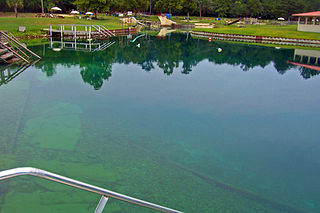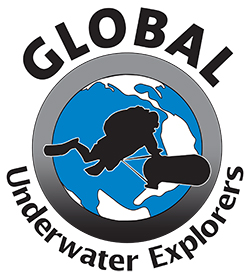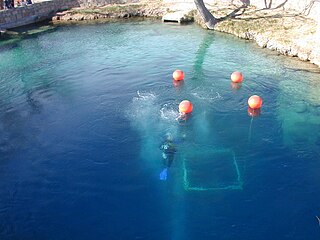Related Research Articles
An overhead or penetration diving environment is where the diver enters a space from which there is no direct, purely vertical ascent to the safety of breathable atmosphere at the surface. Cave diving, wreck diving, ice diving and diving inside or under other natural or artificial underwater structures or enclosures are examples. The restriction on direct ascent increases the risk of diving under an overhead, and this is usually addressed by adaptations of procedures and use of equipment such as redundant breathing gas sources and guide lines to indicate the route to the exit.

Wreck diving is recreational diving where the wreckage of ships, aircraft and other artificial structures are explored. The term is used mainly by recreational and technical divers. Professional divers, when diving on a shipwreck, generally refer to the specific task, such as salvage work, accident investigation or archaeological survey. Although most wreck dive sites are at shipwrecks, there is an increasing trend to scuttle retired ships to create artificial reef sites. Diving to crashed aircraft can also be considered wreck diving. The recreation of wreck diving makes no distinction as to how the vessel ended up on the bottom.

Cave-diving is underwater diving in water-filled caves. It may be done as an extreme sport, a way of exploring flooded caves for scientific investigation, or for the search for and recovery of divers or, as in the 2018 Thai cave rescue, other cave users. The equipment used varies depending on the circumstances, and ranges from breath hold to surface supplied, but almost all cave-diving is done using scuba equipment, often in specialised configurations with redundancies such as sidemount or backmounted twinset. Recreational cave-diving is generally considered to be a type of technical diving due to the lack of a free surface during large parts of the dive, and often involves planned decompression stops. A distinction is made by recreational diver training agencies between cave-diving and cavern-diving, where cavern diving is deemed to be diving in those parts of a cave where the exit to open water can be seen by natural light. An arbitrary distance limit to the open water surface may also be specified.
Sheck Exley was an American cave diver. He is widely regarded as one of the pioneers of cave diving, and he wrote two major books on the subject: Basic Cave Diving: A Blueprint for Survival and Caverns Measureless to Man. On February 6, 1974, Exley became the first chairman of the Cave Diving Section of the American National Speleological Society. During his career, he established many of the basic safety procedures used in cave and overhead diving today. Exley was also a pioneer of extreme deep scuba diving.

Diving activities are the things people do while diving underwater. People may dive for various reasons, both personal and professional. While a newly qualified recreational diver may dive purely for the experience of diving, most divers have some additional reason for being underwater. Recreational diving is purely for enjoyment and has several specialisations and technical disciplines to provide more scope for varied activities for which specialist training can be offered, such as cave diving, wreck diving, ice diving and deep diving. Several underwater sports are available for exercise and competition.

Police diving is a branch of professional diving carried out by police services. Police divers are usually professional police officers, and may either be employed full-time as divers or as general water police officers, or be volunteers who usually serve in other units but are called in if their diving services are required.
Underwater divers may be employed in any branch of an armed force, including the navy, army, marines, air force and coast guard. Scope of operations includes: search and recovery, search and rescue, hydrographic survey, explosive ordnance disposal, demolition, underwater engineering, salvage, ships husbandry, reconnaissance, infiltration, sabotage, counterifiltration, underwater combat and security.
Scuba Schools International (SSI) is a for-profit organization that teaches the skills involved in scuba diving and freediving, and supports dive businesses and resorts. SSI has over 2,500 authorized dealers, 35 regional centers, and offices all over the world.

Vortex Spring is a commercially operated recreation, camping and dive park located near Ponce de Leon, Florida. It is the largest diving facility in the state of Florida.

Underwater search and recovery is the process of locating and recovering underwater objects, often by divers, but also by the use of submersibles, remotely operated vehicles and electronic equipment on surface vessels.

Global Underwater Explorers (GUE) is a scuba diving organization that provides education within recreational, technical, and cave diving. It is a nonprofit membership organization based in High Springs, Florida, United States.

Tom Mount was an American pioneering cave diver and technical diver.

The Blue Hole of Santa Rosa, or simply the Blue Hole, is a circular, bell-shaped pool or small lake located along Route 66 east of Santa Rosa, New Mexico that is a tourist attraction and swimming venue, and one of the most popular dive destinations in the US for scuba diving and training. The Blue Hole is an artesian well and cenote that was once used as a fish hatchery.
Jarrod Michael Jablonski is a pioneering technical diver and record setting cave diver as well as an accomplished business owner and operator. These business operations include Halcyon Manufacturing, Extreme Exposure Adventure Center and Global Underwater Explorers. In July 2021 Jablonski launched and now operates the world's deepest pool at Deep Dive Dubai. Jablonski is one of the main architects behind the 'Doing It Right' system of diving.

Jill Heinerth is a Canadian cave diver, underwater explorer, writer, photographer and film-maker. She has made TV series for PBS, National Geographic Channel and the BBC, consulted on movies for directors including James Cameron, written several books and produced documentaries including We Are Water and Ben's Vortex, about the disappearance of Ben McDaniel.

On August 20, 2010, Ben McDaniel, of Memphis, Tennessee, United States, was reported missing after employees in the dive shop at Vortex Spring, north of Ponce de Leon, Florida, noticed that his pickup truck had remained in the shop's parking lot for the previous two days. McDaniel, who had been diving regularly at the spring while living in his parents' nearby beach house, had last been seen by two of those employees on the evening of August 18, on a dive entering a cave 58 feet (18 m) below the water's surface. While he was initially believed to have drowned on that dive, and his parents still strongly believe his body is in an inaccessible reach of the extensive cave system, no trace of him has ever been found. The state of Florida issued his family a death certificate in 2013.

The following outline is provided as an overview of and topical guide to underwater diving:

The following index is provided as an overview of and topical guide to underwater diving:
International Underwater Cave Rescue and Recovery (IUCRR) is an all-volunteer not-for-profit organization formed in 1999 that provides assistance to law enforcement with underwater rescue and recovery operations.
References
- ↑ "Distressed Diver Saved at Blue Springs". myPanHandle. 2014-11-05. Archived from the original on 2015-07-06. Retrieved 2015-07-06.
- ↑ Sutta, David (2014-06-28). "Cave Diving: Behind The Scenes". CBS Miami . Retrieved 2015-07-06.
- ↑ Morton, Brooke (2013-11-13). "What It's Like to Attempt a Cave Rescue". Scuba Diving. Retrieved 2015-07-06.
- ↑ Kassab, Beth (24 June 2015). "Should cave diving sites have more restrictions?". OrlandoSentinel.com. Retrieved 2015-07-06.
- ↑ Baucom, Bergen (2013-09-18). "Local Cave Diver Featured in Duracell Battery Series". wjhg. Retrieved 2015-07-06.
- ↑ "Edd Sorenson". Cave Adventurers Training. 2014. Archived from the original on 2015-07-06. Retrieved 2015-07-06.
- ↑ "Cave Diver Celebrated for Successful Rescue Efforts". Caving News. 2013-01-21. Retrieved 2015-07-06.
- ↑ Wolff, Cindy (2012-02-19). "Theories about Collierville diver's disappearance swirl in vortex of unanswered questions". MCA. Retrieved 2015-07-06.
- ↑ Lunn, Rosemary E. "Two bodies successfully recovered in Dom Rep". X-Ray Magazine.
- ↑ Flynn, Meagan. "A diver who helped rescue the Thai soccer team was just saved from an underwater cave in Tennessee". The Washington Post .